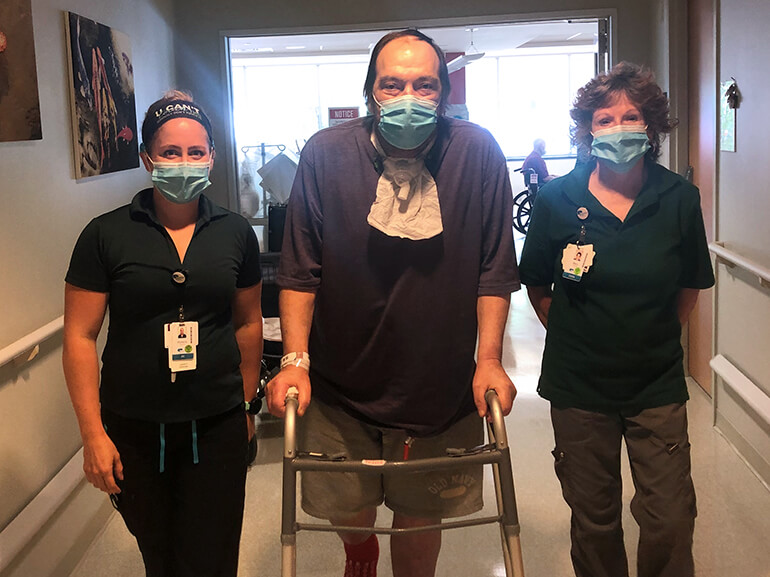Robert's story

In early February, Robert Adams returned home from a quick trip to the gas station. The 60-year-old Lancaster resident stepped out of the car and collapsed in the driveway. Luckily, Robert’s grandson saw him fall and immediately called for help.
An ambulance rushed Robert to Lancaster General Hospital where he was diagnosed with respiratory failure and lack of blood oxygen. He lay unconscious for 11 days on a ventilator, feeding tube and dialysis, the latter was used to clear fluid build-up.
By March 27, Robert turned the corner. He awoke, liberated from the breathing machine and received a tracheostomy for airway support. Early physical therapy commenced with teaching him how to roll to the side of the bed, sit up and eventually take a few assisted steps.
Significantly weak from more than a month in bed, Robert needed additional recovery time. He chose Helen M. Simpson Rehabilitation Hospital because of its positive reputation and experience dealing with cases like his.
Robert arrived with the goal of getting back to his previously active life, but he knew he had a long road of hard work in front of him. Unable to eat solid food, he was on a feeding tube. He also required supplemental oxygen to maintain adequate levels during rest and activity.
Therapy was initially challenging. Robert needed frequent breaks, and required assistance with mobility and management of his oxygen tank. He also had persistent weakness in his both legs which limited his ability to walk far or fast.
Robert and his care team logged many hours in the therapy gym practicing transferring between elevated and lower surfaces. He initially needed two therapists to help him stand. However, as his strength and endurance improved, he became more independent and walked various distances over uneven terrain. This helped prepare him for home tasks such as getting the mail.
Speech and occupational therapy were key to Robert’s rehabilitation. Not only did team members in all specialty areas know his overall status, but they worked in a well-coordinated fashion, helping Robert feel secure every step of the way.
Speech therapists conducted a swallowing study to determine tolerance for various textures. The team educated Robert on chin tuck techniques that assist with proper swallowing of food and prevent aspiration which could lead to pneumonia and increased risk of additional hospitalizations. With proper education and practice, Robert was able to return to a regular diet.
Robert also used a trach collar, a medical device used to secure a trach tube in its position, which was applied as a result of significant medical decline requiring long term intubation/ventilation. Occupational therapists taught Robert trach collar management techniques to avoid snagging or irritating it while dressing. They also provided instruction on adaptive tools to aid bathing and dressing while connected to the trach collar and oxygen tube.
Robert’s girlfriend, Amber, was a constant presence throughout his rehabilitation. She took part in family therapeutic training and received additional tracheostomy care instruction. Robert credits his life to her, noting that “she made all of the important decisions” during the initial hospitalization.
A critical turning point came when Robert walked two laps around the therapy gym, included ascending and descending an outdoor ramp.
“My experience at Helen Simpson has been positive,” he said. “I had a lot of one-on-one time with my physicians and therapists. Dr. Morganstein took the time to explain to me what happened and how to ensure it won’t happen again.”
By the time he left Helen M. Simpson Rehabilitation Hospital on July 3, he could travel up and down stairs, walk with a walker and enjoy favorite foods.
He looked forward to enjoying buffalo chicken pizza, “hugging his sweetie” and seeing family upon returning home. Robert’s experience revealed a previously unknown reservoir of strength that he’s proud to acknowledge.